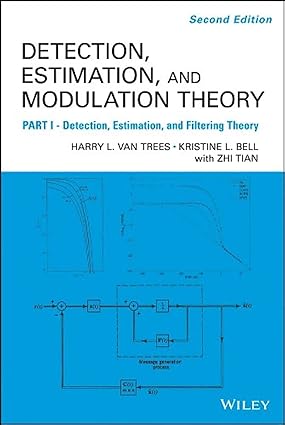
Detection Estimation and Modulation Theory, Part I:Detection, Estimation, and Filtering Theory
Author: Harry L. Van Trees (Author), Kristine L. Bell (Author), Zhi Tian
ASIN: 0470542969
Publisher: Wiley
Edition: 2nd edition
Publication Date: 2013-04-15
Language: English
Hardcover: 1184 pages
ISBN-10: 0470542969
ISBN-13: 9780470542965
Book Description
With a wide range of applications such as radar, sonar, communications, seismology, biomedical engineering, and radar astronomy, among others, the important field of detection and estimation has rarely been given such expert treatment as it is here. Each chapter includes section summaries, realistic examples, and a large number of challenging problems that provide excellent study material. This volume which is Part I of a set of four volumes is the most important and widely used textbook and professional reference in the field.
From the Inside Flap
Since 1968 and after 30 printings of the first edition, Part I of DEMT has been the textbook for the two generations of students and researchers that have designed the signal processing in many of our operational systems. The Second Edition includes subsequent advances, retains clarity of explanation, and promises to be the text and reference for future generations.
-- Dr. Arthur B. Baggeroer, Ford Professor Emeritus, MIT
The First Edition of Detection, Estimation, and Modulation Theory, Part I, enjoyed a long useful life. However, in the forty-four years since its publication, there have been a large number of changes:
- 1. The basic detection and estimation theory has remained the same but numerous new results and algorithms have been obtained.
- 2. The exponential growth in computational capability has enabled us to implement algorithms that were only of theoretical interest in 1968.
- 3. The theoretical results from DEMT have been widely applied in operational systems.
- 4. Simulation became more widely used in system design and analysis, research, and teaching.
The Second Edition is a significant expansion of the first edition with 450 pages of new material. Chapter 2 in the First Edition, Classical Detection and Estimation Theory, is expanded into four chapters. Many more examples are developed in detail to enhance readability, and more non-Gaussian models are included. A large number of significant developments that are appropriate for an introductory text--including global Bayesian bounds, efficient computational algorithms, equivalent estimation algorithms, sequential estimation, and importance sampling--are added. The Fisher and Bayesian linear Gaussian models are studied in more detail. The First Edition emphasized continuous-time random processes. The Second Edition includes a comprehensive development of linear estimation of discrete-time random processes leading to discrete-time Wiener and Kalman filters. A brief introduction to Bayesian estimation of non-Gaussian processes is included. An expanded version of material from Part III develops optimum detectors for continuous-time and discrete-time random processes that can be implemented using Wiener or Kalman filters.
As imperative today as it has been since its original publication in 1968, this work is sure to remain the leading reference for engineers who need to apply detection and estimation theory in diverse systems.
From the Back Cover
"Since 1968 and after 30 printings of the first edition, Part I of DEMT has been the textbook for the two generations of students and researchers that have designed the signal processing in many of our operational systems. The Second Edition includes subsequent advances, retains clarity of explanation, and promises to be the text and reference for future generations."
Dr. Arthur B. Baggeroer, Ford Professor Emeritus, MIT
The First Edition of Detection, Estimation, and Modulation Theory, Part I, enjoyed a long useful life. However, in the forty-four years since its publication, there have been a large number of changes:
- 1. The basic detection and estimation theory has remained the same but numerous new results and algorithms have been obtained.
- 2. The exponential growth in computational capability has enabled us to implement algorithms that were only of theoretical interest in 1968.
- 3. The theoretical results from DEMT have been widely applied in operational systems.
- 4. Simulation became more widely used in system design and analysis, research, and teaching.
The Second Edition is a significant expansion of the first edition with 450 pages of new material. Chapter 2 in the First Edition, Classical Detection and Estimation Theory, is expanded into four chapters. Many more examples are developed in detail to enhance readability, and more non-Gaussian models are included. A large number of significant developments that are appropriate for an introductory text including global Bayesian bounds, efficient computational algorithms, equivalent estimation algorithms, sequential estimation, and importance sampling are added. The Fisher and Bayesian linear Gaussian models are studied in more detail. The First Edition emphasized continuous-time random processes. The Second Edition includes a comprehensive development of linear estimation of discrete-time random processes leading to discrete-time Wiener and Kalman filters. A brief introduction to Bayesian estimation of non-Gaussian processes is included. An expanded version of material from Part III develops optimum detectors for continuous-time and discrete-time random processes that can be implemented using Wiener or Kalman filters.
As imperative today as it has been since its original publication in 1968, this work is sure to remain the leading reference for engineers who need to apply detection and estimation theory in diverse systems.
About the Author
HARRY L. VAN TREES, ScD., received his BSc. from the United States Military Academy and his ScD. from Massachusetts Institute of Technology. During his fourteen years as a Professor of Electrical Engineering at MIT, he wrote Parts I, II, and III of the DEMT series. On loan from MIT, he served in four senior DoD positions including Chief Scientist of the U.S. Air Force and Principal Deputy Assistant Secretary of Defense (C3I). Returning to academia as an endowed professor at George Mason University, he founded the C3I Center and published Part IV of the DEMT series, Optimum Array Processing. He is currently a University Professor Emeritus.
KRISTINE L. BELL, PhD, is a Senior Scientist at Metron, Inc., and an affiliate faculty member in the Statistics Department at George Mason University. She coedited with Dr. Van Trees the Wiley-IEEE book Bayesian Bounds for Parameter Estimation and Nonlinear Filtering/Tracking.
ZHI TIAN, PhD, is a Professor of Electrical and Computer Engineering at Michigan Technological University. She is a Fellow of the IEEE.
 Wow! eBook
Wow! eBook

